
Flintknapping
Advances in technology through the ages have increased human chances of survival through the millennia. The first human technology was flintknapping, beginning over 2.5 million years ago. Flintknapping is the art and skill of creating tools and points out of stone. A hammer stone is used to hit a core stone. The force of the percussion causes a flake of stone to peel off the core rock. Flintknapping is a reduction process, removing many flakes from the core stone. Using a smaller tool such as an antler or bone, pressed along the edge of a tool will force off a small flake. The pressure flakes are removed to sharpen the edges and thin a tool. The “flakes”(called lithics in Archaeology) produced by flintknapping have certain characteristics that identify them as a manmade rock such as a striking platform, a bulb of percussion, a smooth and rippled side, and negative flake scars.
Many types of stone can be used for flintknapping including quartzite, chert, basalt, flint, rhyolite, and obsidian. Green River Preserve has 2 quarry sites, where Native Americans collected the core stones to make their points and tools. One quarry produces a clear and milky quartz and the other produces a metamorphic quartzite. Both rock quarries are less than a mile from base camp.
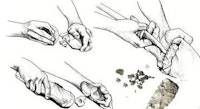
The earliest known examples of flintknapping are Oldowan tools from 2.6 million years ago to 1.5 million years ago. These were crude tools such as scrappers, choppers and simple cutting tools and were most likely used for chopping wood, cutting and preparing animal hides, and processing plants. Archaeological evidence of these tools is found throughout Africa, the Middle East, South Asia, and Europe.
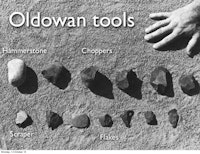
Flintknapping technology changed about 1.5 million years ago into more refined and specialized tools. The Acheulean tools are more sophisticated bifacial tools, meaning they were worked on both sides. These tools were sharper and thinner and a much more effective tool. Not only were they used for cutting and scraping, but they were also used for hunting animals, thus increasing chances of survival. Acheulean hand tools and hand axes are found throughout Africa, Europe, Asia and into the Indian Subcontinent.
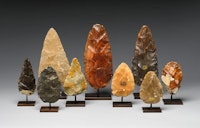
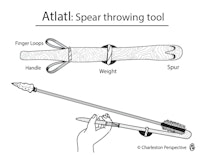
Humans saw incredible advances in flintknapping technology about 40,000 years ago. The Upper Paleolithic tool making tradition developed more specialized and effective tools. The longer thinner blades associated with the Upper Paleolithic were much better suited to make spears used for both protection and hunting local game.
The atlatl was introduced in the Upper Paleolithic resulting in a more efficient and advanced method of wielding the spear points. An atlatl is a spear throwing tool, creating a greater accuracy, velocity and distance when throwing a spear. This would have given the Native Americans a greater advantage in hunting local game.
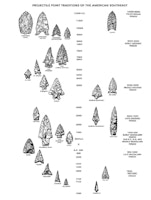
We know that people have been flintknapping in the Southeastern United States for at least 14,000 years, although it may be as much as 40,000 years or more. The tools recovered in archaeology excavations through the years include spearpoints, arrowheads, hand axes, scrapers, knives, drills, hammer stones, axes, mortar and pestle and pounding stones. The spear points and arrow heads have very distinct changes in style and form over thousands of years.
The different styles of points define time periods in history. As a result of many archaeology investigations, a chronology has been developed for the dates of manufacture and the characteristics of the different types of points found in the Southeast.
There are 3 recognized time periods in Native American history (Paleolithic 12,000 BC to 8,000 BC; Archaic 8,000 BC to 1000 BC and Woodland 1000 BC to 1600 AD). Honestly not much is known about early culture and the daily life of the native people of the Southeastern United States. We will explore the cultures of the Native Americans of the Southeast in an upcoming later blog. There is more known about the early cultures of the Native Americans of the Southwest and Central and South America, such as the Anasazi cliff dwellers, the Aztec and the Mayan cultures.
GRP has evidence of Native American occupations dating back to at least 12,000 years ago. We have found examples of each type of point known in the Southeast.
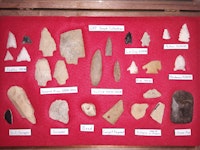
Flintknapping was the first and maybe the most significant technology developed by humans. As the process of creating points and tools from stone progressed, humans had a greater chance of survival by providing protection and a means of procuring game for sustenance, clothing, shoes, and shelter.
There are obvious changes in form and function of spearpoints throughout the different time periods in history. The typology of the spearpoints of the Southeast is the best diagnostic archaeologists have in determining the date of occupation for a Native American site. These changes in styles and types of points show changes in circumstances for the people living at that time; possibly changes in resources, environmental changes, or societal changes. We may never know.
Continuing archaeological investigations and excavations will help to unravel the history of the ancient cultures of the past. Green River Preserve is a perfect place to continue exploring the cultures and daily life of the ancient Native Americans of the Southeast.
Thank you for your interest and support for GRP. Join me in the next blog as we explore the history of the Native American cultures of the Southeast. Until then remember “Culture is Everywhere”.